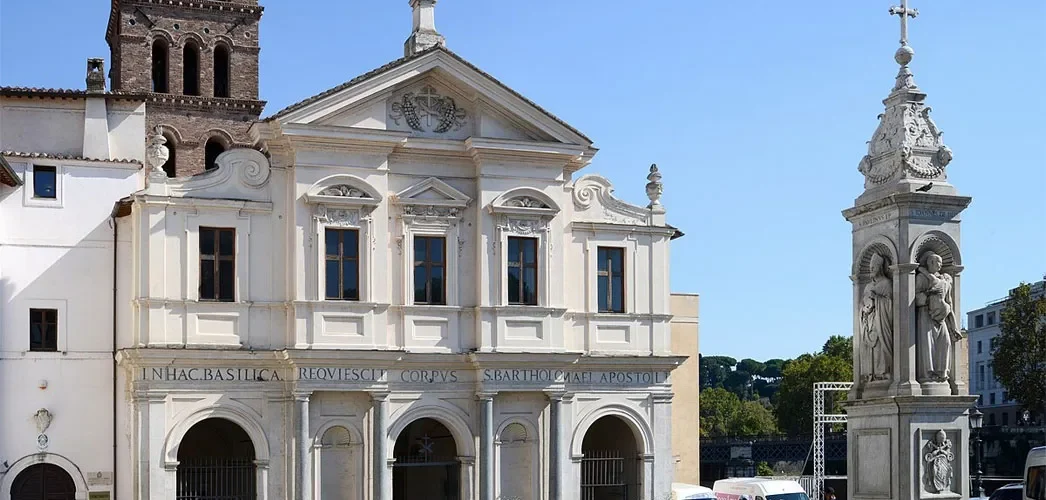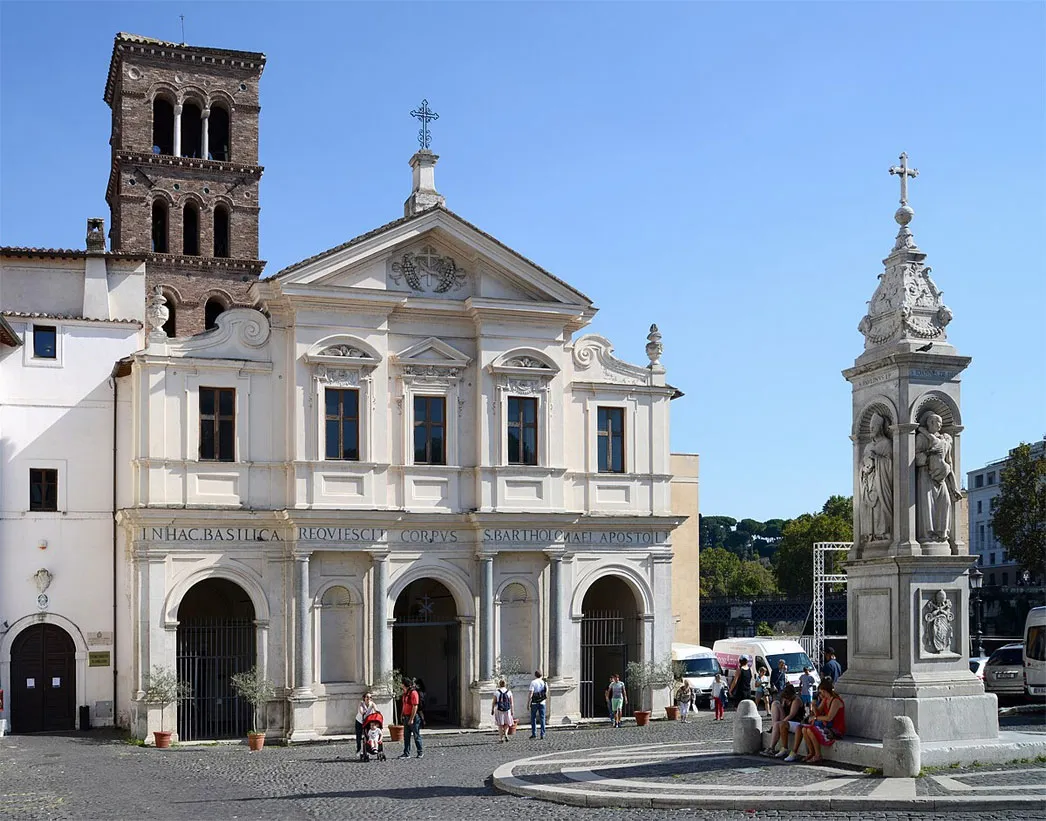
Introduction
Basilica of St. Bartholomew is a 10th century, Roman Catholic church situated on Tiber Island in the middle of the Tiber River. It is a nice little church to visit and one of several interesting things to see on Tiber Island. It was founded in 998 by Otto III, Holy Roman Emperor and contains the putative relics of St. Bartholomew the Apostle. It is located on Tiber Island, on the site of the former temple of Aesculapius, which had cleansed the island of its former ill-repute among the Romans and established its reputation as a hospital, continued under Christian auspices today. Its cardinal priest has been Cardinal Blase Cupich since 19 November 2016.
The basilica of San Bartolomeo all’Isola is over a thousand years old. It stands in Rome, on the Tiber Island, a place of particular importance for the history of Rome, halfway between Trastevere, the district of the first Christian preaching, and the ancient Jewish quarter. This position in the middle of the Tiber, a key place for crossing the river, well expresses one of the most characteristic aspects of this basilica, which gathers memories linked to different and distant worlds, united together in a unique and original synthesis of faith, art and history.
In Roman times, the Temple of Aesculapius stood on the site of the modern church. The entire Isola Tiberina had actually been covered in marble in an effort to make the island look like a ship. The prow can still be seen today. Emperor Otto built this church over the temple’s ruins on the eastern side (downstream end) of the island. It was initially dedicated to Adalbert of Prague.
A portion of the relics of St. Bartholomew was given by Otto II to Rome in 983. The relics were sent to Rome from Benevento, where they had arrived in 838 from Lipari. They are located within an ancient Roman porphyry sarcophagus with lions’ heads, under the main altar. The marble wellhead bears the figures of the Savior, Adalbert, Bartholomew, and Otto III. The association with Aesculapius, and therefore healing, in time caused Bartholomew’s name to become associated with medicine and hospitals.
The church was renovated by Pope Paschal II in 1113 and again in 1180. The church was badly damaged by a flood in 1557 and was reconstructed, with its present Baroque façade, in 1624, to designs of Orazio Torriani. commissioned by Cardinal Trescio. Further restorations were undertaken in 1852. The interior of the church preserves fourteen ancient Roman columns and two lion supports that date from the earliest reconstruction of the basilica.
The inscriptions found in S. Bartolomeo, a valuable source illustrating the history of the Basilica, have been collected and published by Vincenzo Forcella. In 2000, San Bartolomeo was dedicated by Pope John Paul II to the memory of the new martyrs of the 20th and 21st century. In the center of the piazzetta before the church is a four-sided guglia with saints in niches by the sculptor Ignazio Jacometti, erected here in 1869. The 12th-century tower near the church, the Torre dei Caetani, is all that remains of the medieval castello erected on the island by the Pierleoni.
The church has had repeated problems with flooding by the river. As a result, it has needed several restorations. The first recorded was by Pope Paschal II in 1113, who left an inscription above the entrance.
13th century
Pope Martin IV ordered another restoration, which was completed in 1284. It involved laying Cosmatesque flooring (bits of which survive), and a baldacchino with porphyry columns (which does not). The artist responsible for the latter was Ognissanti Callario de’ Tederini. Also, the façade was embellished by further mosaic work which was described as being on a gilded background.
16th century
The church was entrusted to the Franciscan Observants (now incorporated into the Friars Minor) in 1524, and they established a convent here. Their first edifice was erected to the right of the church, and survived until the late 19th century.
17th century
In 1601 the former sacristy, to the left of the apse, was converted into a chapel for the Confraternity of Millers which operated several water-mills on the river nearby. Here were enshrined the relics of SS Paulinus, Adalbert, Exuperantius and Marcellus. The first-named became the patron of the Confraternity, and the chapel was dedicated to him in 1636. The Confraternity moved out in 1846. In 1608, Cardinal Michelangelo Tonti gave Antonio Marziale Carracci the commission to decorate the side chapels. He managed four of them during his work until 1621, although many of the resulting frescoes have since been badly damaged. They are arguably the only important post-mediaeval works of art in the church.
The church was heavily restored in a major project ordered by Pope Urban VIII in 1624. The architect was Martino Longhi the Younger, with at least some help from Orazio Torriani who we now know designed the façade in 1639. This façade was an add-on, lengthening the church. The decoration provided in the restoration was in the Baroque style, giving the church its present appearance.
In 1638 the surviving convent range to the left of the church was built. This meant that the convent had two wings, on either side of the present trapezoidal piazza thus creating an impressive architectural ensemble focusing attention on the new façade. The right hand wing has since been demolished. In 1694 the friars opened a Missionary College here, which survived until the late 19th century.
Architecture of Basilica of St. Bartholomew on the Island Rome
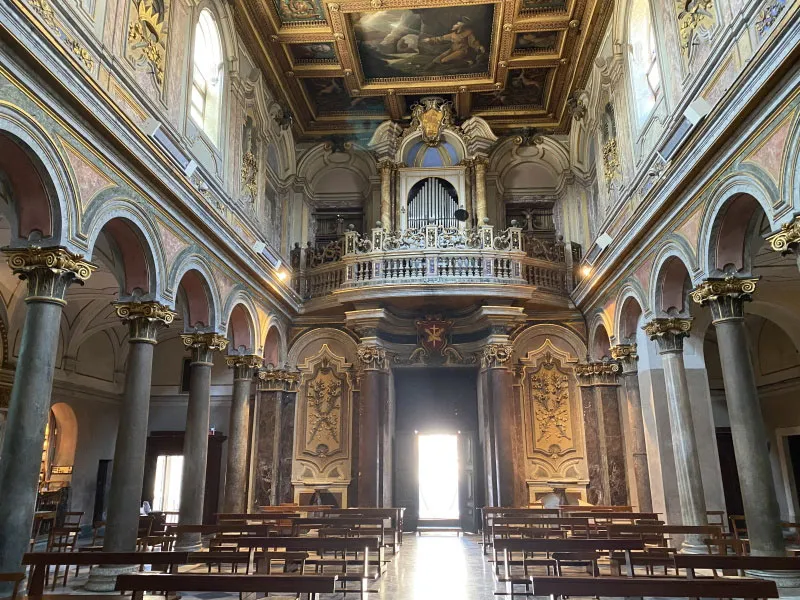
The basilica was built in a place of pilgrimage already known: for centuries, in fact, there had been a temple dedicated to Aesculapius on the Tiber Island, and many people visited the sacred place to implore their healing. In 998, the German emperor Otto III built the church to house the remains of two martyrs: St Bartholomew the Apostle, whose body is kept in the high altar, populations at the northernmost border of Christian Europe.
In the middle of the stairs leading to the presbytery there is the most remarkable element of the church Presbytery and the well curb on the stair the well-curb constituting the ideal link to the ancient Aesculapius temple. The main altar in white marble, gift of the pope Pius IX (see section The history), is supported by a red porphyry basin with a lion shaped prothom, relief handles and a cartouche with the inscription “CORPUS SANCTI BARTHOLOMAEI Porphyry basin supporting the altar APOSTOLI” [Body of the saint Bartholomew] testifying the presence of the St.Bartholomew relics. Two fragments of the old cosmatesco floor are still inserted in the floor. In the apse is represented the “St.Bartholomew martyrdom” by Francesco Manno (1806) who performed also the architectural restoration of the apse, while the “Crhist in glory and saints” in the apse basin and the other frescoes are by Bonaventura Loffredo.
Saint Bartholomew
San Bartolomeo houses the memorial to new martyrs of the 20th and 21st century, which was dedicated by Pope John Paul II in 2000. This memorial is taken care of by the Community of Sant’Egidio, who also painted the icon on the main altar. One of the relics that are kept as part of the memorial is the piece of rock that was used in 1984 to kill Blessed Jerzy Popiełuszko.
According to the Roman Martyrology St Bartholomew suffered martyrdom in the Roman province of Armenia. It is recorded that he was first skinned alive and then put to death by decapitation. Five centuries later and half-way across the Mediterranean his relics were found in Lipari, Sicily. Most likely they arrived here through normal means; however, a pious tradition contends that this transfer occurred miraculously. This tradition claims that the sarcophagus of St Bartholomew was thrown into the sea by infidels.
It then floated upon the water until it finally and miraculously came to the shores of the tiny island of Lipari. Regardless, how the relics arrived they remained on this island until the middle of the 9th century. At this time they were transferred to Benevento, Italy and then in the latter part of the 10th century they were brought to Rome by the Holy Roman Emperor, Otto III, where they were interred in the church of San Bartolomeo all’Isola on Tiber Island. This final transfer, however, is contested by the city of Benevento which continues to claim possession of the true relics of St Bartholomew.
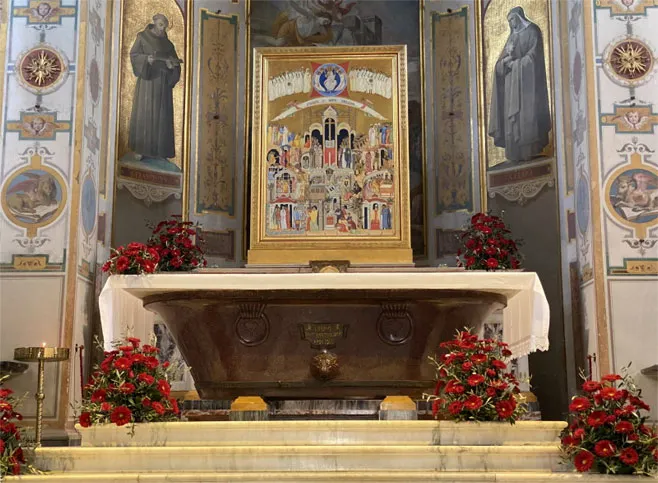
St Bartholomew’s Relics
The 6th-century writer in Constantinople, Theodorus Lector, averred that in about 507 Emperor Anastasius gave the body of Bartholomew to the city of Dura-Europos, which he had recently re-founded. The existence of relics at Lipari, a small island off the coast of Sicily, in the part of Italy controlled from Constantinople, was explained by Gregory of Tours by his body having miraculously washed up there: a large piece of his skin and many bones that were kept in the Cathedral of St Bartholomew the Apostle, Lipari, were translated to Beneventum in 803, and to Rome in 983 by Holy Roman Emperor Otto II, conserved at the basilica of San Bartolomeo all’Isola. In time, the church there inherited an old pagan medical centre. This association with medicine in course of time caused Bartholomew’s name to become associated with medicine and hospitals. Some of Bartholomew’s skull was transferred to the Frankfurt Cathedral, while an arm was venerated in Canterbury Cathedral.
Miracles of St. Bartholomew
Saint Bartholomew many miracles performed by Bartholomew before and after his death, two very popular ones are known by the townsfolk of the small island of Lipari. The people of Lipari celebrated his feast day annually. The tradition of the people was to take the solid silver and gold statue from inside the Cathedral of St Bartholomew and carry it through the town. On one occasion, when taking the statue down the hill towards the town, it suddenly became very heavy and had to be set down. When the men carrying the statue regained their strength, they lifted it a second time. After another few seconds, it got even heavier. They set it down and attempted once more to pick it up. They managed to lift it but had to put it down one last time. Within seconds, walls further downhill collapsed. If the statue had been able to be lifted, all the towns people would have been killed.
During World War II, the Fascist regime looked for ways to finance their activities. The order was given to take the silver statue of St Bartholomew and melt it down. The statue was weighed, and it was found to be only a few grams. It was returned to its place in the Cathedral of Lipari. In reality, the statue is made from many kilograms of silver and it is considered a miracle that it was not melted down. St. Bartholomew is credited with many other miracles having to do with the weight of objects.
The Well
The new building brought about a transformation in the fabric of the Tiber Island, expressive of the general change that took place in the city of Rome following the spread of Christianity. The well in the basilica, a very rare case, is an example of this process: it probably dates back to Roman times and its waters were considered thaumaturgical. Christians have been able to preserve and enhance that tradition: the well has become an evangelical symbol. In fact, in the ancient marble vera that overlooks it, there is a central image of Jesus that suggests to the beholder an association with the words from the Gospel of John: “He who is thirsty, let him come to me and drink who believes in me; as the Scripture says, rivers of living water will flow from his bosom”.
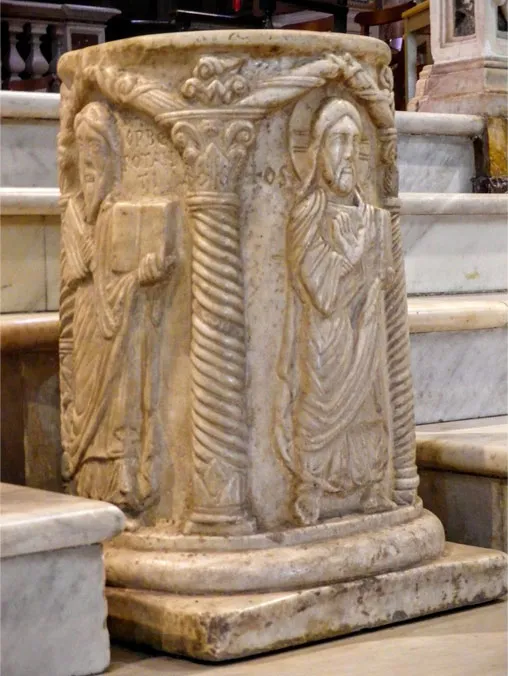
Nave
There are fourteen ancient marble columns in the nave arcades, seven on each side, which were formerly thought to have come from the original temple. This is now considered unlikely, since they are too small. However, two of the bases are tentatively identified as possibly belonging to the temple; the fifth, on right and left. The columns are of different heights, and the bases are a mixed bunch so the builders of the church played at mix-and-match. You can see how they chose a tall base for a short column, and vice versa. However, in places they had to make do with mortar to fill a gap -rather a risky thing to do, although no harm came of it.
Annual Feast Day
Feast day: August 24th
Basilica of St. Bartholomew on the Island Feast Day August 24th
Opening Hours of the Basilica
Monday to Saturday : 9:30 AM, 1:30 PM, 3:30 PM, 5:30 PM.
Sunday : 9:30 AM, 1:00 PM, 3:30 PM, 5:30 PM.
Mass Timing
Monday to Friday : 8:00 PM.
Sunday : 11:30 AM, 6:30 PM.
Contact Info
Basilica di San Bartolomeo all’Isola,
Piazza S. Bartolomeo all’Isola,
22, Rome,
Italy.
Phone No.
Tel :+39 06 687 7973
Accommodations
Connectivities
Airway
Salzburg airport to St. Bartholomew’s Church distance 34 min (30.8 km) via B305
Railway
Rome Termini Railway Station to Basilica of St. Bartholomew Distance 20 min (4.7 km) via Via Nazionale

